Refined Evaluation of Soil Quality Sustainability in the Main Grain-Producing Areas of Heilongjiang Province
Abstract
:1. Introduction
2. Materials and Methods
2.1. Indicators for Evaluating Soil Quality Sustainability
2.1.1. Soil Erosion
2.1.2. Land Crop Production Potential
2.1.3. Soil Nutrient Balance
2.1.4. Heavy Metal Contamination of Soils
2.1.5. SOC Storage
2.2. Fuzzy Clustering Analysis
2.3. Refined Evaluation
2.4. Study Area
2.5. Data Collection and Processing
2.5.1. Soil Erosion Modulus
2.5.2. Land Crop Production Potential
2.5.3. Soil Nutrient Balance Index
2.5.4. Soil Heavy Metal Contamination and SOC Storage
3. Results
3.1. Changes in Soil Quality Indicators
3.2. Soil Quality Sustainability
4. Discussion
4.1. Analyses of Differences in the Spatial Distribution of SQS
4.2. Limitations and Perspectives
5. Conclusions
Supplementary Materials
Author Contributions
Funding
Data Availability Statement
Conflicts of Interest
Appendix A. RULSE Model (Section 2.1.1)
| Factor | Unit | Calculation Method | Description of Parameters |
|---|---|---|---|
| R | P—annual rainfall, mm. | ||
| K | Sa—sand content, Si—chalk content, Cl—clay content and C—organic carbon content. | ||
| LS | Dimensionless | θ—slope of the corresponding raster point (°), λ—slope length of the corresponding raster point (m). | |
| C | Dimensionless | —surface reflectance in the near-infrared band, —surface reflectance in the visible band. | |
| P | Dimensionless | See table below | The value of P ranges from 0 to 1, with 0 representing an area free of erosion after water conservation measures, and 1 being used to indicate an area without any water conservation measures. |
| Slope (%) | Arable Land | Wood Land | Grass Land | Water Area | Settlements and Cities | Unused Land |
|---|---|---|---|---|---|---|
| 0–1 | 1 | 1 | 1 | 0 | 0 | 1 |
| 1–9 | 0.3 | 0.8 | ||||
| 9–18 | 0.5 | |||||
| 18–21 | 0.6 | |||||
| >21 | 1 | 1 |
Appendix B. Production Potential (Section 2.1.2)
| Parameters | Calculation Formula | Formula Parameter Breakdown |
|---|---|---|
| Photosynthetic production potential | ε—physiological radiation coefficient, α—radiation absorption rate, β—radiation leakage rate, γ—light saturation limitation rate; ω—respiration consumption rate, Φ—quantum conversion efficiency, X—plant water content, H—mass–energy conversion coefficient, Q—total solar radiation intensity reaching the ground (J·cm−2). | |
| Light and temperature production potential | (cool-loving crops) (heat-loving crops) | T0—the optimum temperature for crop growth (taken as 20 °C), T—the actual temperature for crop growth (°C); a—the temperature-related parameters are as follows: when T < T0, a = −1; and when T ≥ T0, a = −2. |
| Climate production potential | R—precipitation (mm), E0—maximum evaporation when soil moisture supply is adequate (mm). | |
| Land production potential | M, N, P and K are the affiliation values of each fertility factor of soil organic matter, fast-acting nitrogen, fast-acting pity and fast-acting potassium available to crops in the arable layer, and a, b, c and d are the relative weight coefficients of the contribution of these four factors to crop yield, respectively. |
Appendix C. Soil Nutrient Balance (Section 2.1.3)
References
- Robinson, D.A.; Fraser, I.; Dominati, E.J.; Davidsdottir, B.; Jonsson, J.O.G.; Jones, L.; Jones, S.B.; Tuller, M.; Lebron, I.; Bristow, K.L.; et al. On the Value of Soil Resources in the Context of Natural Capital and Ecosystem Service Delivery. Soil Sci. Soc. Am. J. 2014, 78, 685–700. [Google Scholar] [CrossRef] [Green Version]
- Brevik, E.C.; Sauer, T.J. The past, present, and future of soils and human health studies. Soil 2015, 1, 35–46. [Google Scholar] [CrossRef]
- Ji, X.; Han, M.; Ulgiati, S. Optimal allocation of direct and embodied arable land associated to urban economy: Understanding the options deriving from economic globalization. Land Use Policy 2020, 91, 104392. [Google Scholar] [CrossRef]
- Wang, J.; Xu, X.; Pei, J.; Li, S. Current Situations of Black Soil Quality and Facing Opportunities and Challenges in Northeast China. Chin. J. Soil Sci. 2021, 52, 695–701. [Google Scholar]
- Xingwu, D.; Li, R.; Guangli, Z.; Jinming, H.; Haiyan, F. Soil productivity in the Yunnan province: Spatial distribution and sustainable utilization. Soil Tillage Res. 2015, 147, 10–19. [Google Scholar] [CrossRef]
- Zhang, G.; Bai, J.; Xi, M.; Zhao, Q.; Lu, Q.; Jia, J. Soil quality assessment of coastal wetlands in the Yellow River Delta of China based on the minimum data set. Ecol. Indic. 2016, 66, 458–466. [Google Scholar] [CrossRef]
- He, C.; Han, Q.; de Vries, B.; Wang, X.; Guochao, Z. Evaluation of sustainable land management in urban area: A case study of Shanghai, China. Ecol. Indic. 2017, 80, 106–113. [Google Scholar] [CrossRef]
- Ramadani, I.; Bytyqi, V. Processes Affecting Sustainable Use of Agricultural Land in Kosovo. Quaest. Geogr. 2018, 37, 53–66. [Google Scholar] [CrossRef] [Green Version]
- Fu, J.; Bu, Z.; Jiang, D.; Lin, G.; Li, X. Sustainable land use diagnosis based on the perspective of production–living–ecological spaces in China. Land Use Policy 2022, 122, 106386. [Google Scholar] [CrossRef]
- Nziguheba, G.; Adewopo, J.; Masso, C.; Nabahungu, N.L.; Six, J.; Sseguya, H.; Taulya, G.; Vanlauwe, B. Assessment of sustainable land use: Linking land management practices to sustainable land use indicators. Int. J. Agric. Sustain. 2022, 20, 265–288. [Google Scholar] [CrossRef]
- Li, X.; Li, H.; Yang, L.; Ren, Y. Assessment of Soil Quality of Croplands in the Corn Belt of Northeast China. Sustainability 2018, 10, 248. [Google Scholar] [CrossRef] [Green Version]
- Zhao, R.; Li, J.; Wu, K.; Kang, L. Cultivated Land Use Zoning Based on Soil Function Evaluation from the Perspective of Black Soil Protection. Land 2021, 10, 605. [Google Scholar] [CrossRef]
- Geng, S.B.; Shi, P.L.; Zong, N.; Zhu, W.R. Using Soil Survey Database to Assess Soil Quality in the Heterogeneous Taihang Mountains, North China. Sustainability 2018, 10, 3443. [Google Scholar] [CrossRef] [Green Version]
- Xie, X.-F.; Pu, L.-J.; Zhu, M.; Wu, T.; Xu, Y. Assessment of Soil Quality in Coastal Tidal Flat Reclamation Areas Based on MDS-TOPSIS Model. Huanjing Kexue 2019, 40, 5484–5492. [Google Scholar]
- Ouyang, X.; Wang, J.; Chen, X.; Zhao, X.; Ye, H.; Watson, A.E.; Wang, S. Applying a projection pursuit model for evaluation of ecological quality in Jiangxi Province, China. Ecol. Indic. 2021, 133, 108414. [Google Scholar] [CrossRef]
- Pang, J.; Liu, X.; Huang, Q. A new quality evaluation system of soil and water conservation for sustainable agricultural development. Agric. Water Manag. 2020, 240, 106235. [Google Scholar] [CrossRef]
- Khan, J.; Singh, R.; Upreti, P.; Yadav, R.K. Geo-statistical assessment of soil quality and identification of Heavy metal contamination using Integrated GIS and Multivariate statistical analysis in Industrial region of Western India. Environ. Technol. Innov. 2022, 28, 102646. [Google Scholar] [CrossRef]
- Tengberg, A.; Radstake, F.; Zhang, K.; Dunn, B. Scaling up of Sustainable Land Management in the Western People’s Republic of China: Evaluation of a 10-Year Partnership. Land Degrad. Dev. 2016, 27, 134–144. [Google Scholar] [CrossRef]
- Shao, Z.; Huq, M.E.; Cai, B.; Altan, O.; Li, Y. Integrated remote sensing and GIS approach using Fuzzy-AHP to delineate and identify groundwater potential zones in semi-arid Shanxi Province, China. Environ. Model. Softw. 2020, 134, 104868. [Google Scholar] [CrossRef]
- Chen, S.; Arrouays, D.; Angers, D.A.; Chenu, C.; Barré, P.; Martin, M.P.; Saby, N.P.A.; Walter, C. National estimation of soil organic carbon storage potential for arable soils: A data-driven approach coupled with carbon-landscape zones. Sci. Total Environ. 2019, 666, 355–367. [Google Scholar] [CrossRef]
- Liang, C.-P.; Lin, T.-C.; Suk, H.; Wang, C.-H.; Liu, C.-W.; Chang, T.-W.; Chen, J.-S. Comprehensive assessment of the impact of land use and hydrogeological properties on the groundwater quality in Taiwan using factor and cluster analyses. Sci. Total Environ. 2022, 851, 158135. [Google Scholar] [CrossRef] [PubMed]
- Zhang, Q.; Qin, W.; Cao, W.; Jiao, J.; Yin, Z.; Xu, H. Response of erosion reduction effect of typical soil and water conservation measures in cropland to rainfall and slope gradient changes and their applicable range in the Chinese Mollisols Region, Northeast China. Int. Soil Water Conserv. Res. 2022, 11, 251–262. [Google Scholar] [CrossRef]
- Li, S.; Zhao, Y.; Xiao, W.; Yellishetty, M.; Yang, D. Identifying ecosystem service bundles and the spatiotemporal characteristics of trade-offs and synergies in coal mining areas with a high groundwater table. Sci. Total Environ. 2022, 807, 151036. [Google Scholar] [CrossRef]
- Yang, J.; Xie, B.; Tao, W.; Zhang, D. Ecosystem Services Assessment, Trade-off, and Bundles in the Yellow River Basin, China. Diversity 2021, 13, 308. [Google Scholar] [CrossRef]
- Kumar, N.; Singh, S.K. Soil erosion assessment using earth observation data in a trans-boundary river basin. Nat. Hazards 2021, 107, 1–34. [Google Scholar] [CrossRef]
- Chen, Y.; Donohue, R.J.; McVicar, T.R.; Waldner, F.; Mata, G.; Ota, N.; Houshmandfar, A.; Dayal, K.; Lawes, R.A. Nationwide crop yield estimation based on photosynthesis and meteorological stress indices. Agric. For. Meteorol. 2020, 284, 107872. [Google Scholar] [CrossRef]
- Das, P.P.; Singh, K.R.B.; Nagpure, G.; Mansoori, A.; Singh, R.P.; Ghazi, I.A.; Kumar, A.; Singh, J. Plant-soil-microbes: A tripartite interaction for nutrient acquisition and better plant growth for sustainable agricultural practices. Environ. Res. 2022, 214, 113821. [Google Scholar] [CrossRef]
- Gujre, N.; Rangan, L.; Mitra, S. Occurrence, geochemical fraction, ecological and health risk assessment of cadmium, copper and nickel in soils contaminated with municipal solid wastes. Chemosphere 2021, 271, 129573. [Google Scholar] [CrossRef]
- Hakanson, L. An ecological risk index for aquatic pollution control.a sedimentological approach. Water Res. 1980, 14, 975–1001. [Google Scholar] [CrossRef]
- Lorenz, K.; Lal, R.; Ehlers, K. Soil organic carbon stock as an indicator for monitoring land and soil degradation in relation to United Nations’ Sustainable Development Goals. Land Degrad. Dev. 2019, 30, 824–838. [Google Scholar] [CrossRef]
- Horáček, M.; Samec, P.; Minár, J. The mapping of soil taxonomic units via fuzzy clustering—A case study from the Outer Carpathians, Czechia. Geoderma 2018, 326, 111–122. [Google Scholar] [CrossRef]
- Hengl, T. Finding the right pixel size. Comput. Geosci. 2006, 32, 1283–1298. [Google Scholar] [CrossRef]
- IPCC. Intergovernmental Panel on Climate Change—2019 Refinement to the 2006 IPCC Guidelines for National Greenhouse Gas Inventory; IPCC: Kyoto, Japan, 2019. [Google Scholar]
- Li, M.; Cao, X.; Liu, D.; Fu, Q.; Li, T.; Shang, R. Sustainable management of agricultural water and land resources under changing climate and socio-economic conditions: A multi-dimensional optimization approach. Agric. Water Manag. 2022, 259, 107235. [Google Scholar]
- Schweizer, S.A.; Fischer, H.; Häring, V.; Stahr, K. Soil structure breakdown following land use change from forest to maize in Northwest Vietnam. Soil Tillage Res. 2017, 166, 10–17. [Google Scholar] [CrossRef]
- Zheng, H.; Wang, L.; Peng, W.; Zhang, C.; Li, C.; Robinson, B.E.; Wu, X.; Kong, L.; Li, R.; Xiao, Y.; et al. Realizing the values of natural capital for inclusive, sustainable development: Informing China’s new ecological development strategy. Proc. Natl. Acad. Sci. USA 2019, 116, 8623–8628. [Google Scholar] [CrossRef] [Green Version]
- Sapkota, T.B.; Bijay, S.; Takele, R. Chapter Five—Improving nitrogen use efficiency and reducing nitrogen surplus through best fertilizer nitrogen management in cereal production: The case of India and China. In Advances in Agronomy; Sparks, D.L., Ed.; Academic Press: Cambridge, MA, USA, 2023; pp. 233–294. [Google Scholar]
- Svanbäck, A.; McCrackin, M.L.; Swaney, D.P.; Linefur, H.; Gustafsson, B.G.; Howarth, R.W.; Humborg, C. Reducing agricultural nutrient surpluses in a large catchment—Links to livestock density. Sci. Total Environ. 2019, 648, 1549–1559. [Google Scholar] [CrossRef]
- Hu, B.; Shao, S.; Ni, H.; Fu, Z.; Hu, L.; Zhou, Y.; Min, X.; She, S.; Chen, S.; Huang, M.; et al. Current status, spatial features, health risks, and potential driving factors of soil heavy metal pollution in China at province level. Environ. Pollut. 2020, 266, 114961. [Google Scholar] [CrossRef] [PubMed]
- Hu, W.; Wang, H.; Dong, L.; Huang, B.; Borggaard, O.K.; Hansen, H.C.B.; He, Y.; Holm, P.E. Source identification of heavy metals in peri-urban agricultural soils of southeast China: An integrated approach. Environ. Pollut. 2018, 237, 650–661. [Google Scholar]
- Cheng, Y.; Li, P.; Xu, G.; Wang, X.; Li, Z.; Cheng, S.; Huang, M. Effects of dynamic factors of erosion on soil nitrogen and phosphorus loss under freeze-thaw conditions. Geoderma 2021, 390, 114972. [Google Scholar] [CrossRef]
- Schneider, F.; Don, A.; Hennings, I.; Schmittmann, O.; Seidel, S.J. The effect of deep tillage on crop yield—What do we really know? Soil Tillage Res. 2017, 174, 193–204. [Google Scholar] [CrossRef]
- Tian, P.; Lian, H.; Wang, Z.; Jiang, Y.; Li, C.-F.; Sui, P.; Qi, H. Effects of Deep and Shallow Tillage with Straw Incorporation on Soil Organic Carbon, Total Nitrogen and Enzyme Activities in Northeast China. Sustainability 2020, 12, 8679. [Google Scholar] [CrossRef]
- Severini, S.; Castellari, M.; Cavalli, D.; Pecetti, L. Economic Sustainability and Riskiness of Cover Crop Adoption for Organic Production of Corn and Soybean in Northern Italy. Agronomy 2021, 11, 766. [Google Scholar] [CrossRef]
- Han, C.; Chen, S.; Yu, Y.; Xu, Z.; Zhu, B.; Xu, X.; Wang, Z. Evaluation of Agricultural Land Suitability Based on RS, AHP, and MEA: A Case Study in Jilin Province, China. Agriculture 2021, 11, 370. [Google Scholar] [CrossRef]
- Ristić, V.; Maksin, M.; Nenković-Riznić, M.; Basarić, J. Land-use evaluation for sustainable construction in a protected area: A case of Sara mountain national park. J. Environ. Manag. 2018, 206, 430–445. [Google Scholar] [CrossRef] [PubMed]
- Liu, X.; Xin, L.; Lu, Y. National scale assessment of the soil erosion and conservation function of terraces in China. Ecol. Indic. 2021, 129, 107940. [Google Scholar] [CrossRef]
- Filho, J.D.S.O.; Vieira, J.N.; da Silva, E.M.R.; de Oliveira, J.G.B.; Pereira, M.G.; Brasileiro, F.G. Assessing the effects of 17 years of grazing exclusion in degraded semi-arid soils: Evaluation of soil fertility, nutrients pools and stoichiometry. J. Arid. Environ. 2019, 166, 1–10. [Google Scholar] [CrossRef]
- Xiao, R.; Wang, S.; Li, R.; Wang, J.J.; Zhang, Z. Soil heavy metal contamination and health risks associated with artisanal gold mining in Tongguan, Shaanxi, China. Ecotoxicol. Environ. Saf. 2017, 141, 17–24. [Google Scholar] [CrossRef]
- Harris, S.; McDowell, R.W.; Lilburne, L.; Laurenson, S.; Dowling, L.; Guo, J.; Pletnyakov, P.; Beare, M.; Palmer, D. Developing an indicator of productive potential to assess land use suitability in New Zealand. Environ. Sustain. Indic. 2021, 11, 100128. [Google Scholar] [CrossRef]
- Zou, S.; Zhang, L.; Huang, X.; Osei, F.B.; Ou, G. Early ecological security warning of cultivated lands using RF-MLP integration model: A case study on China’s main grain-producing areas. Ecol. Indic. 2022, 141, 109059. [Google Scholar] [CrossRef]
- Zhao, W.; Ma, J.; Liu, Q.; Song, J.; Tysklind, M.; Liu, C.; Wang, D.; Qu, Y.; Wu, Y.; Wu, F. Comparison and application of SOFM, fuzzy c-means and k-means clustering algorithms for natural soil environment regionalization in China. Environ. Res. 2023, 216, 114519. [Google Scholar] [CrossRef]
- Tripathi, R.; Nayak, A.K.; Shahid, M.; Lal, B.; Gautam, P.; Raja, R.; Mohanty, S.; Kumar, A.; Panda, B.B.; Sahoo, R.N. Delineation of soil management zones for a rice cultivated area in eastern India using fuzzy clustering. Catena 2015, 133, 128–136. [Google Scholar] [CrossRef]
- Goudriaan, J.; Laar, H.H.V. Modelling Potential Crop Growth Processes. In Current Issues in Production Ecology; Kluwer Academic Publishers: Dordrecht, The Netherlands, 1994. [Google Scholar]
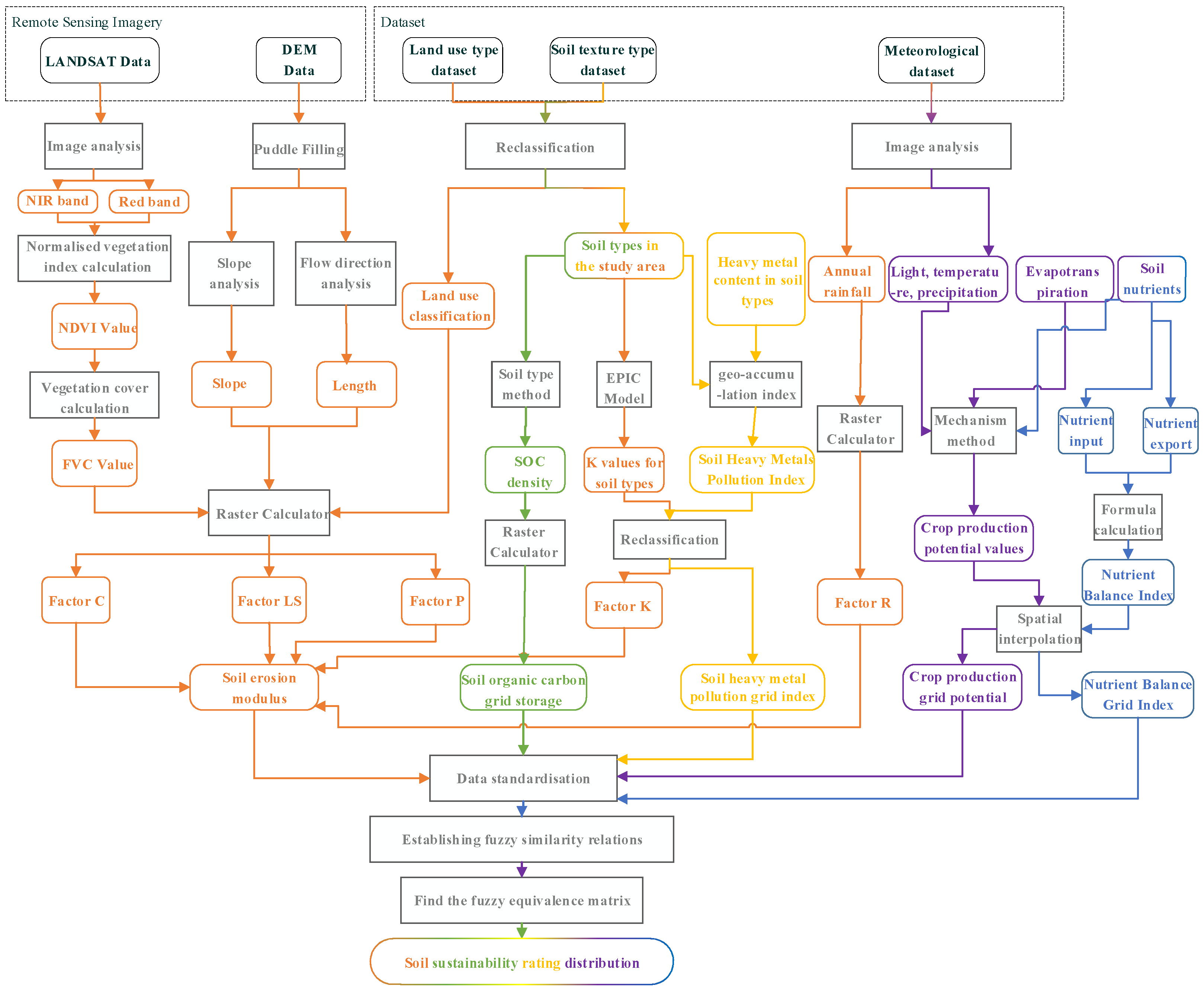

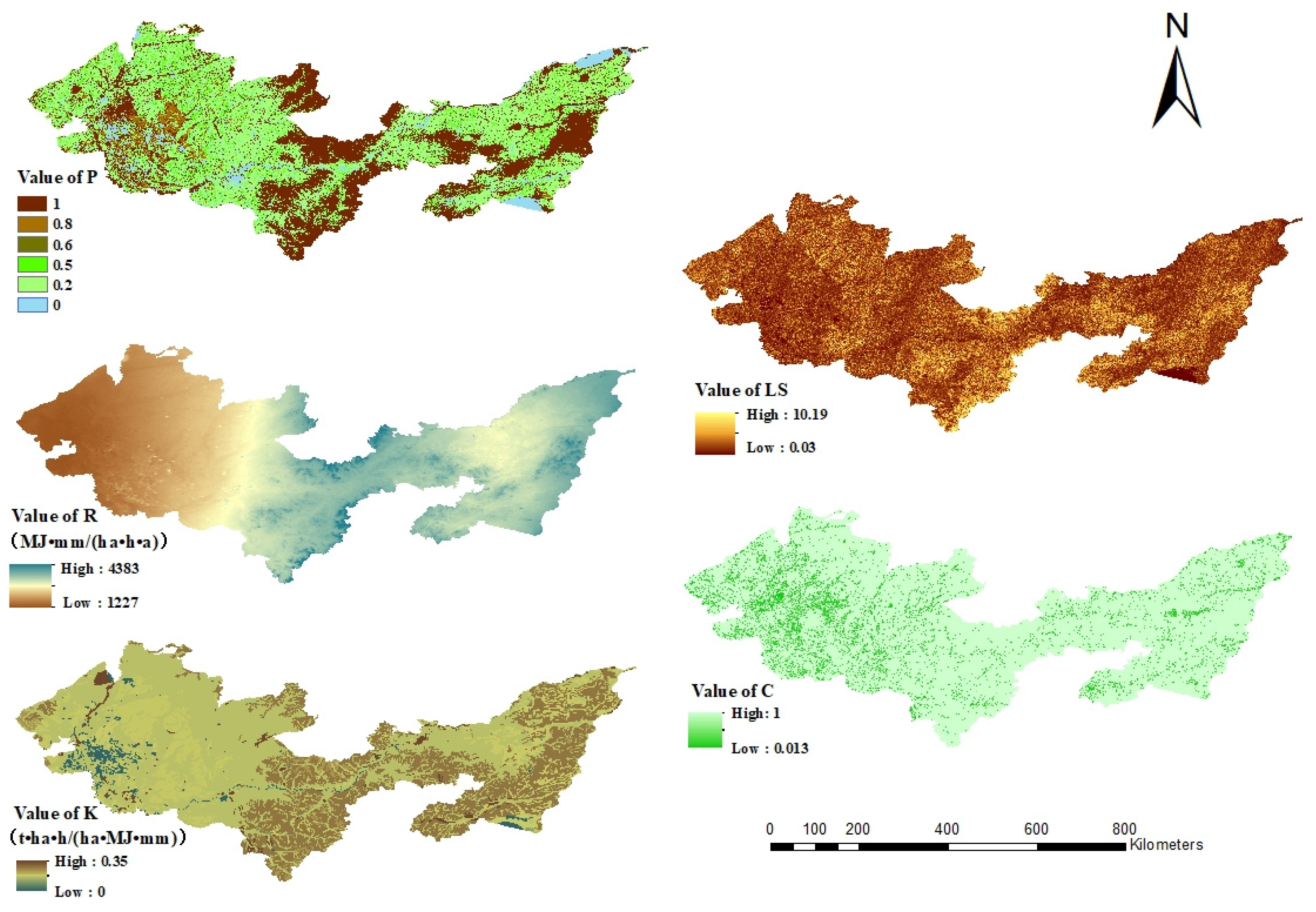
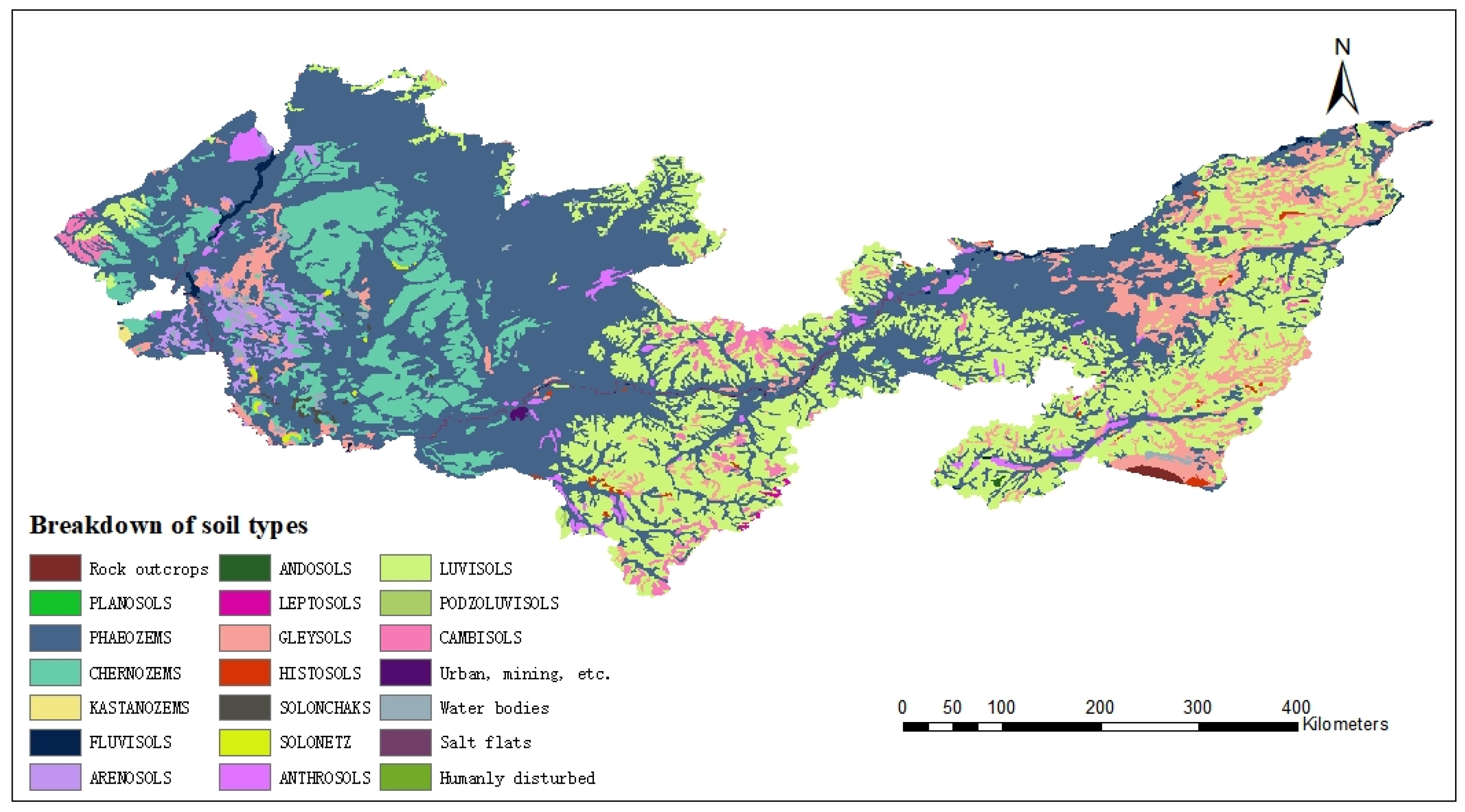
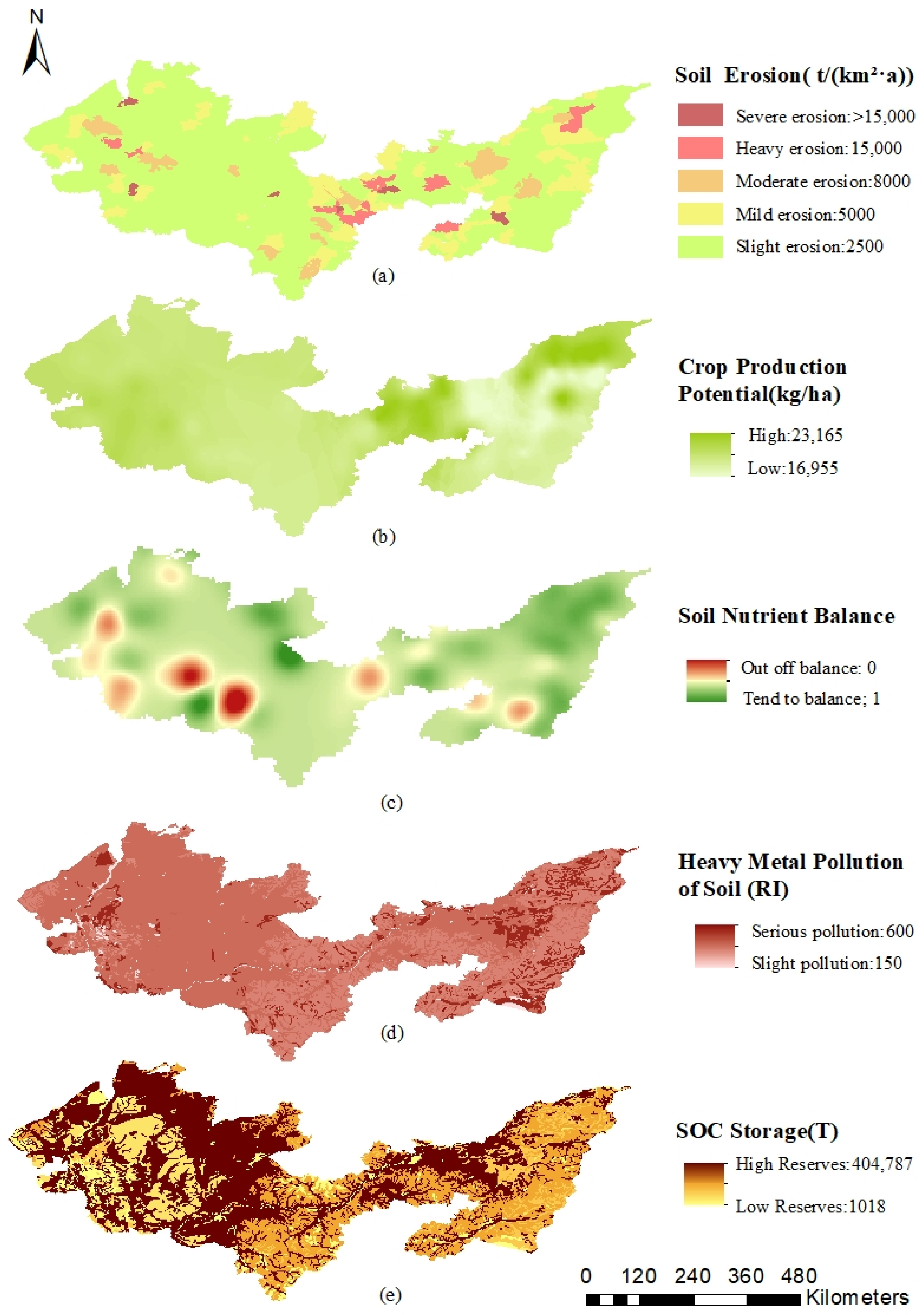
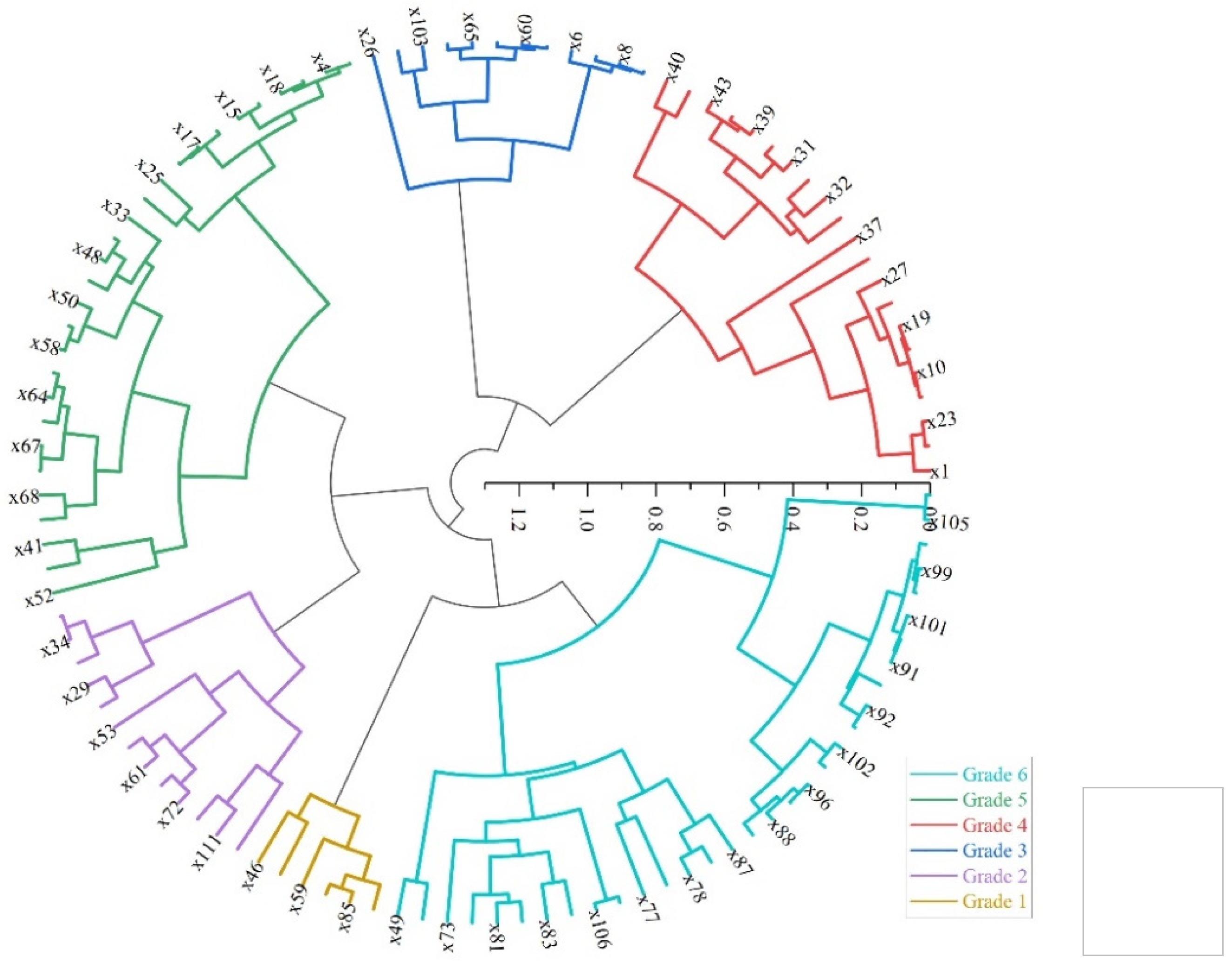
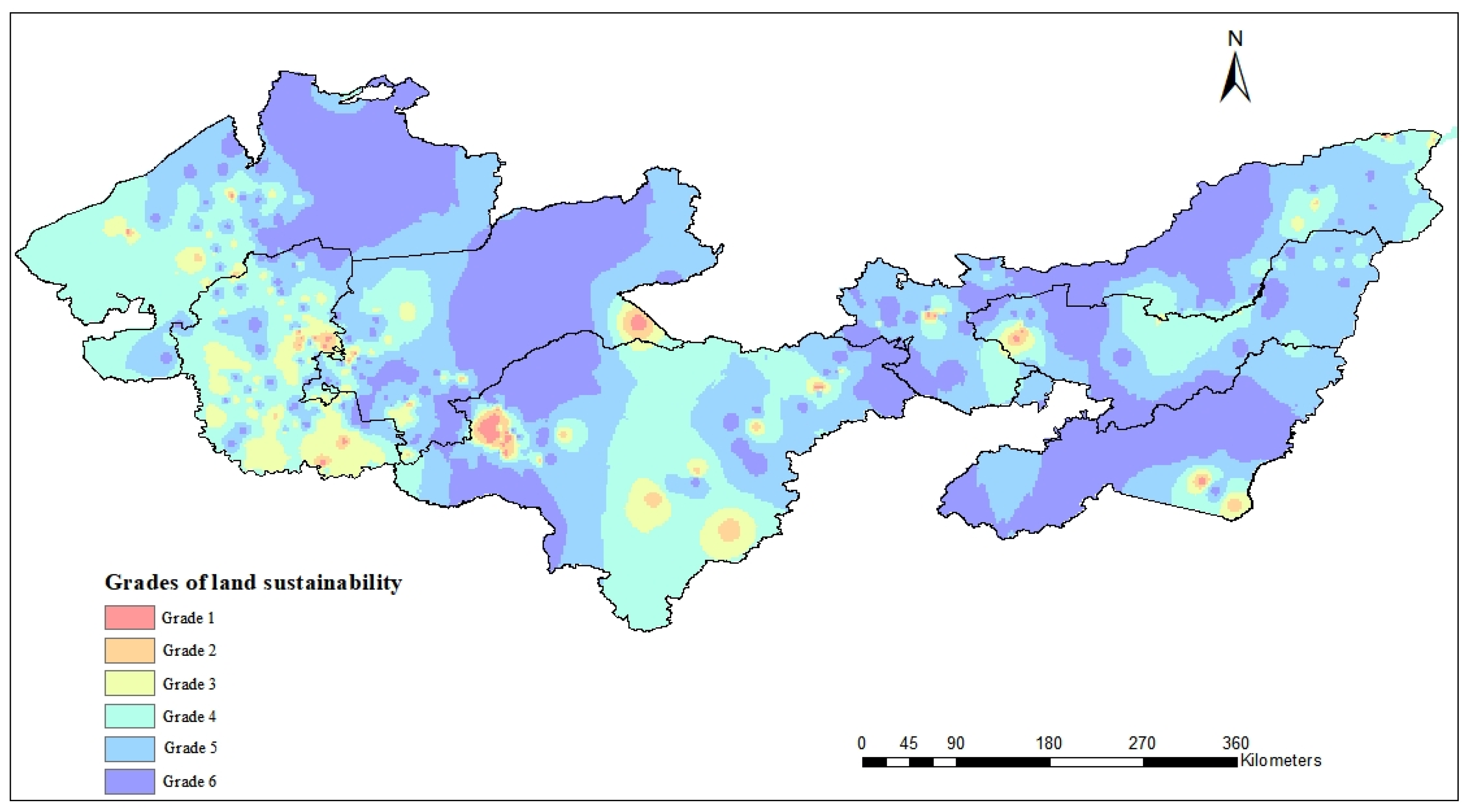
| Element | Mass Fraction of Elements in Fertilizer | Mass Fraction of Elements in Organic Fertilizer | Mass Fraction of Elements in Irrigation Water (mg/kg) | Elements in Atmospheric Dry and Wet Deposition (kg/ha) |
|---|---|---|---|---|
| N | 1.00% | 1.78% | 1.82 | 27.6 |
| P | 2.05% | 0.77% | 1.497 | 1.52 |
| K | 0.49% | 0.78% | 2.245 | 8.3 |
| Crop | Crop Acreage (ha) | Grass Valley Ratio | Crop Yield (t) | Dry Matter Ratio | Nitrogen Fixation (kg/ha) |
|---|---|---|---|---|---|
| Wheat | 3681 | 0.632 | 15,772 | 89% | 15 |
| Rice | 1,530,140 | 0.570 | 13,864,714 | 89% | 30 |
| Corn | 523,560 | 0.559 | 5,235,388 | 87% | 15 |
| Soybeans | 801,942 | 1.295 | 2,063,299 | 91% | 126.83 |
| Influencing Factors | Value | Unit |
|---|---|---|
| Ammonia volatilization loss factor for chemical nitrogen fertilizers | 21.30 | % |
| Ammonia volatilization loss factor for organic fertilizers | 23.01 | % |
| Fertilizer N surface runoff loss factor | 0.343 | % |
| Surface runoff loss factor for soil nitrogen from paddy fields | 3.225 | kg/ha |
| Loss factor for surface runoff of nitrogen from dryland soils | 2.345 | kg/ha |
| Subsurface leaching loss factor for fertilizer N | 0.528 | % |
| Loss factor for subsurface leaching of soil N | 3.161 | kg/ha |
| Nitrogen loss factor due to nitrification/denitrification of chemical nitrogen fertilizers | 1.103 | % |
| Nitrogen loss factor due to nitrification/denitrification of organic fertilizers | 1.000 | % |
| Element | Cd | Hg | As | Pb | Cr | Ni |
|---|---|---|---|---|---|---|
| Background values Bn (mg·kg−1) | 0.079 | 0.016 | 9.33 | 22.7 | 50.82 | 24.16 |
| Toxicity factor Ti | 30 | 40 | 10 | 5 | 2 | 5 |
| Soil Erosion Modulus (t·km−2·a−1) | Degree of Soil Erosion | Ratio of Area (%) |
|---|---|---|
| 0–2500 | Slight erosion | 89.65 |
| 2500–5000 | Mild erosion | 5.09 |
| 5000–8000 | Moderate erosion | 3.11 |
| 8000–15,000 | Heavy erosion | 1.67 |
| >15,000 | Severe erosion | 0.48 |
| Land Quality Sustainability Grade | Evaluation Factors | |||||
|---|---|---|---|---|---|---|
| Soil Erosion | SOC Storage | Soil Nutrient Balance | Heavy Metal Contamination of Soils | Crop Production Potential | ||
| Grade 1 | 0–25 points | Severe erosion | Low | Severe imbalance | Severe pollution | Low |
| Grade 2 | 25–40 points | Severe erosion | Relatively low | heavy pollution | Low | |
| Grade 3 | 40–55 points | Heavy erosion | Moderate | Slight imbalance | Moderate pollution | Relatively low |
| Grade 4 | 55–70 points | Moderate erosion | Moderate | Moderate pollution | Moderate | |
| Grade 5 | 70–85 points | Mild erosion | Relatively High | More balanced | Mild pollution | Relatively High |
| Grade 6 | 85–100 points | Slight erosion | High | Slight pollution | High | |
Disclaimer/Publisher’s Note: The statements, opinions and data contained in all publications are solely those of the individual author(s) and contributor(s) and not of MDPI and/or the editor(s). MDPI and/or the editor(s) disclaim responsibility for any injury to people or property resulting from any ideas, methods, instructions or products referred to in the content. |
© 2023 by the authors. Licensee MDPI, Basel, Switzerland. This article is an open access article distributed under the terms and conditions of the Creative Commons Attribution (CC BY) license (https://creativecommons.org/licenses/by/4.0/).
Share and Cite
Zhou, Y.; Liu, J.; Li, H.; Sun, N.; Li, M. Refined Evaluation of Soil Quality Sustainability in the Main Grain-Producing Areas of Heilongjiang Province. Agronomy 2023, 13, 2072. https://doi.org/10.3390/agronomy13082072
Zhou Y, Liu J, Li H, Sun N, Li M. Refined Evaluation of Soil Quality Sustainability in the Main Grain-Producing Areas of Heilongjiang Province. Agronomy. 2023; 13(8):2072. https://doi.org/10.3390/agronomy13082072
Chicago/Turabian StyleZhou, Yan, Jiazhe Liu, Haiyan Li, Nan Sun, and Mo Li. 2023. "Refined Evaluation of Soil Quality Sustainability in the Main Grain-Producing Areas of Heilongjiang Province" Agronomy 13, no. 8: 2072. https://doi.org/10.3390/agronomy13082072





